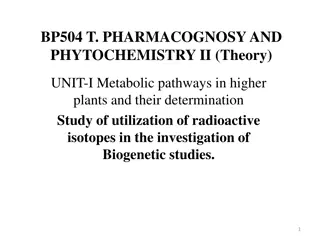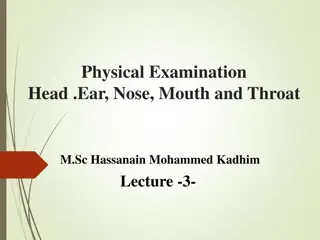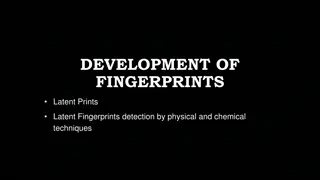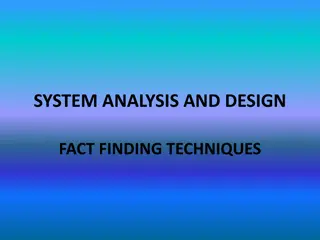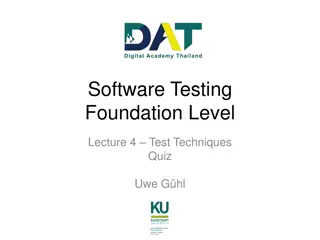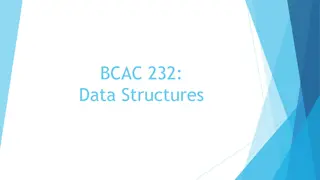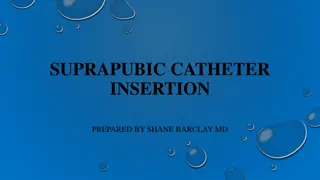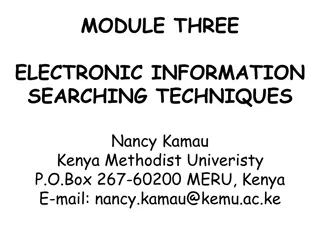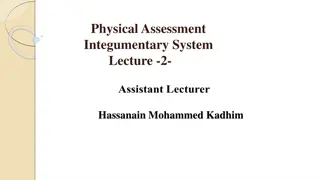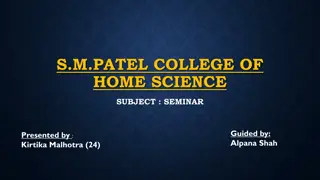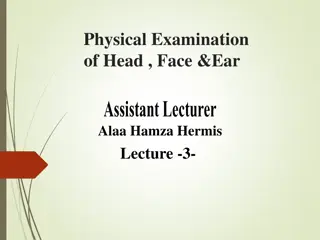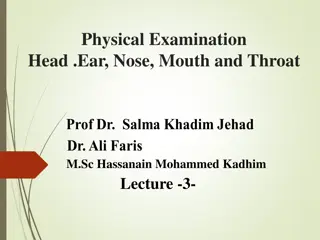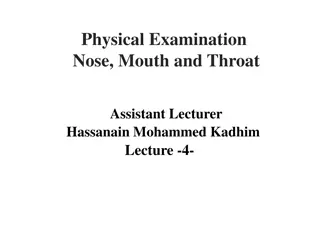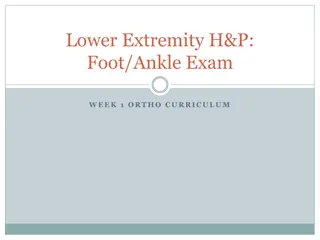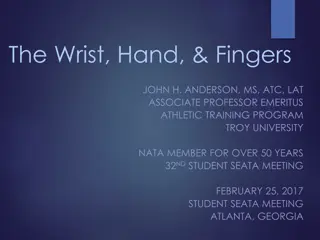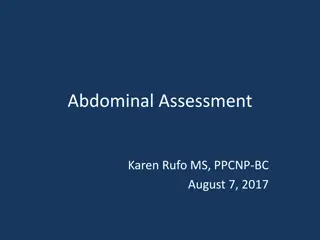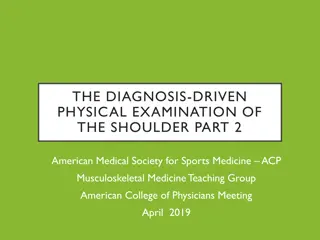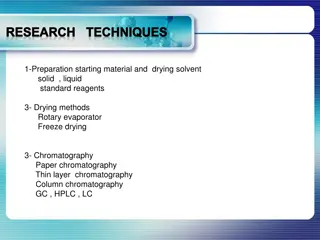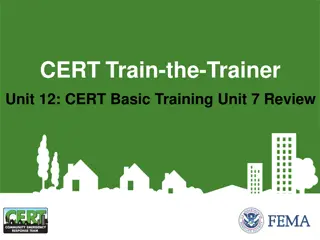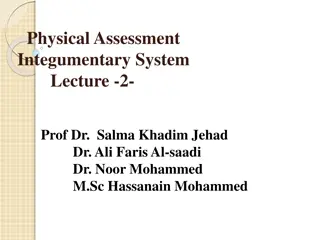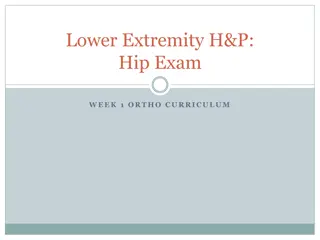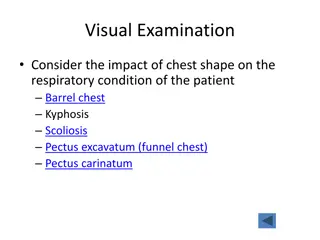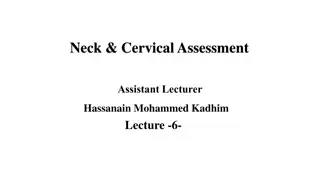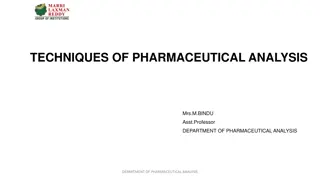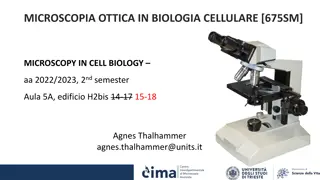Musculoskeletal System Assessment Guidelines
Learn how to conduct a thorough musculoskeletal system assessment, including functional assessments and physical examination guidelines. Explore assessment techniques for ADLs, gait observation, joint palpation, muscle strength testing, and more in nursing practice.
1 views • 17 slides
Understanding Kinesiology Taping Techniques and Benefits
Kinesiology taping is a technique utilizing thin, flexible tape to relieve pain, reduce swelling, and provide support to muscles and joints. Introduced by Dr. Kenzo Kase in the 1970s, it includes techniques such as muscle, ligament, fascial, correction, lymphatic drainage, and functional movement te
8 views • 14 slides
Understanding Measurement Scales and Scaling Techniques
Measurement scales play a crucial role in marketing research, with techniques like scaling helping to categorize data. The content discusses four types of measurement scales: nominal, ordinal, interval, and ratio, outlining their characteristics and differences. Scaling techniques involve placing re
5 views • 7 slides
Techniques for Investigating Plant Metabolic Pathways and Biogenetic Studies
This content explores various techniques used in pharmacognosy and phytochemistry to investigate the metabolic pathways in plants and study the formation of primary and secondary metabolites. Methods such as utilizing radioactive isotopes, tracer techniques, isolated organs/tissues, grafting, and mu
4 views • 12 slides
Comprehensive Examination of Head, Ear, Nose, Mouth, and Throat
Learn how to safely and accurately conduct a thorough examination of the head, ear, mouth, nose, and throat, document assessment data, identify problems, and address client's concerns. The examination covers aspects such as symmetry, shape, scalp inspection, palpation, face inspection including colo
0 views • 29 slides
Veterinary Clinical Examination Techniques and Procedures
Learn about the essential veterinary clinical examination techniques including distant examination (inspection), physical examination (palpation, percussion), auscultation, and more. Understand the importance of visual observation, hands-on assessment, and listening to internal organ sounds in diagn
5 views • 24 slides
Counterfeit Detection Techniques in Currency to Combat Financial Fraud
Currency counterfeiting poses a significant challenge to the financial systems of countries worldwide, impacting economic growth. This study explores various counterfeit detection techniques, emphasizing machine learning and image processing, to enhance accuracy rates in identifying counterfeit curr
0 views • 15 slides
Understanding Fingerprint Development Techniques
Exploring the development of latent fingerprints through physical and chemical methods, conditions affecting latent prints, and various fingerprint development techniques like visual examination, powder techniques, and chemical techniques. Techniques such as alternate light sources and powder method
2 views • 22 slides
Understanding Fact Finding Techniques in System Analysis and Design
Fact finding techniques play a crucial role in collecting essential data and information for system analysis and design. Techniques include sampling existing documentation, research, observation, questionnaires, interviews, prototyping, and joint requirements planning. Extracting facts accurately is
1 views • 8 slides
Understanding Shoulder Anatomy and Common Disorders
The shoulder is a complex joint consisting of multiple components like joints, muscles, ligaments, and capsules. Understanding its anatomy is crucial for diagnosing common disorders such as rotator cuff issues, tendinitis, tears, and frozen shoulder. History, examination, and palpation techniques ar
2 views • 21 slides
Understanding Test Techniques in Software Testing
Explore test techniques in software testing including checklist-based testing, black-box test techniques, decision coverage, statement coverage, and their relationships. Learn how these techniques contribute to effective software testing practices.
2 views • 38 slides
Understanding Sorting Techniques in Data Structures
Sorting is the process of arranging elements in a specific order, be it ascending or descending, for efficient data access. This content covers internal and external sorting, types of sorting techniques like Bubble Sort and Quick Sort, factors influencing the selection of sorting techniques, efficie
7 views • 12 slides
Leprosy Nerve Examination by Dr. N. K. Kansal
This informative content provides a detailed guide on leprosy nerve examination conducted by Dr. N. K. Kansal, an Associate Professor. It covers the procedure for palpation of a nerve, emphasizing correct patient positioning and gentle palpation techniques. The importance of comparing nerves on both
0 views • 16 slides
Urban Design Techniques for City Improvement
Urban design techniques play a crucial role in urban improvement by providing concepts and tools for city building. Some of these techniques include the Open Space Technique, Transportation System Technique, Capital Network Technique, Public Policies Technique, Physical Design Technique, Plug-in Tec
1 views • 11 slides
Abdominal Examination in Pregnancy: Techniques and Objectives
Examination of the abdomen in pregnancy involves assessing various aspects such as determining gestational age, measuring symphysis-fundus height, evaluating fetal lie and presentation, checking liquor amount, listening to fetal heart sounds, and monitoring fetal movements. The process includes gene
0 views • 38 slides
Understanding Artificial Intelligence Techniques
Artificial Intelligence (AI) techniques leverage knowledge representation to achieve generalization, ease of adaptation, and problem-solving capabilities. Knowledge, although voluminous and dynamic, is crucial for developing effective AI solutions. By capturing important properties and enabling adju
0 views • 25 slides
Suprapubic Catheter Insertion Procedure Guidelines
Suprapubic catheter insertion is a procedure indicated for conditions such as urethral injury, obstruction, bladder neck masses, and benign prostatic hypertrophy. It involves proper patient positioning, analgesia, equipment preparation, and a step-by-step technique including bladder palpation, marki
1 views • 12 slides
Mastering Electronic Information Searching Techniques
Electronic information searching requires thorough preparation and the use of various search techniques to retrieve valuable information. This module by Nancy Kamau from Kenya Methodist University covers the process of search preparation, importance of search techniques, and developing effective sea
0 views • 44 slides
Integumentary System Assessment Techniques Lecture
Explore the physical assessment techniques for the integumentary system, focusing on the skin, hair, and nails. Learn about inspection and palpation methods, nail assessment criteria including shape variations, and skin assessment parameters such as color, texture, and pigmentation. Discover how to
0 views • 22 slides
Comprehensive Clinical Evaluation of Children with Cardiac Abnormalities
Initial clinical evaluation of a child with possible cardiac abnormalities includes history taking and physical examination. History should cover symptoms related to pulmonary and systemic venous congestion, cyanosis, cyanotic spells, palpitations, chest pain, and more. The general physical examinat
0 views • 65 slides
Awareness and Techniques of Garment Recycling Among Housewives
This seminar conducted at S.M. Patel College of Home Science focused on studying the awareness of garment recycling and techniques adopted by housewives from different socio-economic backgrounds. The study aimed to promote the reuse and reprocessing of textiles to reduce waste. Through data collecti
0 views • 22 slides
Best Practices for Rectal Palpation in Veterinary Medicine
Rectal palpation is a crucial diagnostic method in veterinary medicine for assessing the reproductive health of animals like cows, buffaloes, mares, and camels. This technique helps in determining the normal and abnormal conditions of genital organs, aiding in pregnancy diagnosis and differentiating
0 views • 18 slides
Comprehensive Physical Examination of Head, Face, and Ear
This content provides detailed guidance on conducting a thorough physical examination of the head, face, and ear. It covers objectives such as safely completing the examination, documenting assessment data accurately, and evaluating findings. The preparation, general approach, and specific inspectio
0 views • 21 slides
Comprehensive Physical Examination of Head, Ear, Nose, Mouth, and Throat
This material outlines the objectives and preparations for a comprehensive examination of the head, ear, nose, mouth, and throat, including key assessment techniques such as inspection and palpation. It covers aspects like symmetry, abnormalities, scalp palpation, facial inspection, and more, aiding
0 views • 29 slides
Comprehensive Guide to Physical Examination of Nose, Mouth, and Throat
This detailed guide covers the preparation, general approach, equipment needed, subjective data collection, inspection, and palpation techniques for assessing the nose, mouth, and throat during a physical examination. It includes step-by-step instructions, visual aids, and information on normal find
0 views • 15 slides
Lower Extremity H&P: Foot/Ankle Exam Overview
The lower extremity H&P for foot/ankle examination in orthopedic curriculum involves various steps such as general ortho physical exam maneuvers, inspection for redness and deformities, palpation of specific areas for tenderness and fractures, range of motion assessment, muscle strength testing, and
0 views • 7 slides
Crafting Literary Analyses: Study of Poetry Themes and Language Techniques
Explore an insightful approach to analyzing poetry themes and language techniques through a structured paragraph template. Delve into five poems, dissect their themes and techniques, and craft personal responses to each piece. Uncover the beauty of poetry with a systematic examination that includes
0 views • 4 slides
Comprehensive Evaluation of the Wrist, Hand, and Fingers
This detailed assessment covers the history, inspection, palpation, and range of motion tests for the wrist, hand, and fingers to evaluate potential injuries or conditions affecting these areas. Includes information on pain location, deformities, ligament evaluations, and joint movements.
0 views • 40 slides
Comprehensive Guide to Abdominal Assessment Methods
Learn the critical order of examination for abdominal assessment, including inspection, auscultation, percussion, and palpation. Understand how to assess skin characteristics, symmetry, abdominal muscles, bowel sounds, vascular sounds, organ size, and tenderness. Discover techniques to identify abno
0 views • 72 slides
Diagnosis-Driven Physical Examination of the Shoulder Part 2: Key Considerations and Case Study
This resource delves into the diagnosis-driven physical examination of shoulder conditions, covering common conditions, key historical factors, and provocative maneuvers for differential diagnosis. It presents an organizational scheme for musculoskeletal assessments and details various shoulder cond
0 views • 34 slides
Essential Techniques in Chemical Research
Learn about key research techniques in chemistry including preparation methods, drying techniques, chromatography, spectroscopic techniques, and specific solvents used. Understand the importance of starting material preparation, drying reagents such as calcium chloride and molecular sieves, and how
0 views • 15 slides
CERT Basic Training Unit 7 Review: Search & Rescue Techniques
In the CERT Basic Training Unit 7 Review, participants learn essential search and rescue techniques including conducting size-up assessments, interior and exterior searches, survivor rescue methods, and safe debris removal. The learning objectives focus on identifying size-up requirements, demonstra
0 views • 13 slides
Heart and Neck Vessels Assessment Overview
This information presents a comprehensive guide for heart and neck vessels assessment, including objectives, necessary equipment, preparation steps, subjective data to consider, techniques for palpating and auscultating the carotid artery, normal findings, and more. It emphasizes the importance of s
0 views • 23 slides
Comprehensive Guide to Integumentary System Assessment Techniques
Learn the essential techniques for assessing the integumentary system, including skin, hair, and nails, through inspection and palpation. Understand how to evaluate nail health based on color, shape abnormalities like spoon shape or clubbing, and texture variations. Explore skin assessment criteria,
0 views • 21 slides
Understanding Fingerprint Development Techniques
Latent fingerprints are hidden impressions left by the friction ridges of the skin which require physical or chemical techniques for visualization. Factors affecting latent prints include surface type, touch manner, weather, humidity, perspiration, and suspect care. Techniques such as visual examina
0 views • 22 slides
Comprehensive Lower Extremity Hip Examination in Orthopedic Curriculum
This detailed guide covers the key components of a hip exam in orthopedics, including inspection, palpation, range of motion assessment, muscle strength testing, and special tests. It emphasizes the importance of considering the joints above and below the hip joint when evaluating a patient's sympto
0 views • 7 slides
Comprehensive Visual and Physical Assessment Techniques for Respiratory Conditions
This comprehensive guide covers the visual, palpation, auscultation, percussion, and pathological processes involved in assessing respiratory conditions. It discusses the impact of chest shape variations like barrel chest, kyphosis, scoliosis, pectus excavatum, and pectus carinatum on respiratory he
0 views • 6 slides
Comprehensive Guide to Neck and Cervical Assessment by Hassanain Mohammed Kadhim
Learn how to inspect the neck for appearance and movement, differentiate between normal and abnormal findings, and perform palpation techniques for the trachea, thyroid gland, and cervical lymph nodes. Discover the important landmarks and characteristics to assess during a neck examination.
0 views • 13 slides
Analytical Techniques in Pharmaceutical Analysis
Analytical techniques play a crucial role in determining the identification and concentration of chemical substances in pharmaceutical analysis. Techniques range from simple gravimetric analysis to sophisticated methods using specialized instrumentation. Various techniques like gravimetric, titrimet
0 views • 17 slides
Microscopic Techniques in Cell Biology: Lessons and Labs Overview
Explore the fascinating world of optical microscopy in cellular biology, covering topics such as image formation, contrasting techniques, fluorescence microscopy, live-imaging techniques, and quantitative microscopy. Dive into the principles behind various microscopy techniques and experimental labs
0 views • 7 slides



